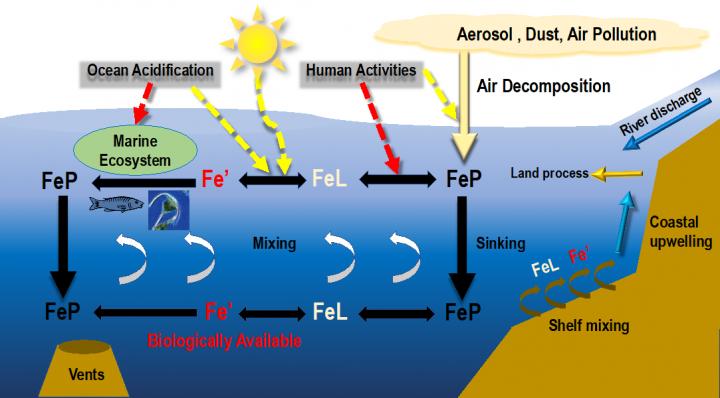Tracing iron in the North Pacific

This is the iron cycle in the ocean. Credit: Yuntao Wang
“As a result of human activity, the amount and composition of Fe induced by atmospheric decomposition has changed and affected the ocean. After depositing into the ocean, the distribution and transport of Fe is mainly determined by physical processes, e.g., mixing and upwelling.
So, clarifying the sources and transport of biologically available Fe are key scientific questions for understanding the marine ecosystem,” explains Dr. Fei Chai, a researcher at the Second Institute of Oceanography and corresponding author of a project report recently published in Atmospheric and Oceanic Science Letters.
“The biological availability of Fe in the ocean also depends on the amount and strength of organic complex ligands. The spatial distribution of Fe-binding ligands is highly variable, with more ligands found in the Northwest Pacific than Northeast Pacific.
Also, the strength of ligands is mainly affected by the pH of water, with lower pH reducing the strength of ligands and decreasing the Fe uptake rate of diatoms. Therefore, under the influence of ocean acidification, the distribution and strength of Fe-binding ligands will change considerably, with subsequent impacts on the ecosystem of the North Pacific,” adds Dr. Chai.
Dr. Fei Chai and his team, from the Second Institute of Oceanography, will develop and utilize a coupled physical-biological-Fe model, named ROMS-CoSiNE-Fe, in the North Pacific.
The model will incorporate the Fe cycle for the upper North Pacific and make predictions of primary production and marine ecosystems in the future. The project is funded by the National Natural Science Foundation of China from 2018 to 2022.
“These studies will explore the sources and transport of biologically available Fe in the HNLC region. The results can give scientific advice to stakeholders on the feasibility of conducting ocean Fe fertilization,” says Dr. Chai, “In the future, we hope to better understand the rate of Fe uptake by phytoplankton and make predictions of changes in the marine ecosystem of the North Pacific.”
Media Contact
All latest news from the category: Earth Sciences
Earth Sciences (also referred to as Geosciences), which deals with basic issues surrounding our planet, plays a vital role in the area of energy and raw materials supply.
Earth Sciences comprises subjects such as geology, geography, geological informatics, paleontology, mineralogy, petrography, crystallography, geophysics, geodesy, glaciology, cartography, photogrammetry, meteorology and seismology, early-warning systems, earthquake research and polar research.
Newest articles

Properties of new materials for microchips
… can now be measured well. Reseachers of Delft University of Technology demonstrated measuring performance properties of ultrathin silicon membranes. Making ever smaller and more powerful chips requires new ultrathin…

Floating solar’s potential
… to support sustainable development by addressing climate, water, and energy goals holistically. A new study published this week in Nature Energy raises the potential for floating solar photovoltaics (FPV)…

Skyrmions move at record speeds
… a step towards the computing of the future. An international research team led by scientists from the CNRS1 has discovered that the magnetic nanobubbles2 known as skyrmions can be…




















